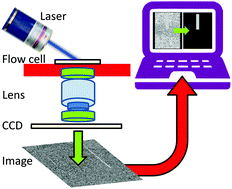A computational streak mode cytometry biosensor for rare cell analysis
Abstract
Streak mode imaging flow cytometry for rare cell detection involves imaging moving fluorescently labeled cells in the video mode with a CCD camera. The path of the moving cells results in a “streak”, whose length is proportional to the exposure time. The dynamic imaging conditions introduce detection challenges (e.g., images with high signal-to-noise ratio (SNR) backgrounds), especially for enumerating cells using low resolution webcams or smartphone cameras suitable for point of care testing (POCT). To overcome the imaging challenges, a new approach called a “computational biosensor” was developed. It involves combining biosensing hardware with computational algorithms to “computationally transduce” measureable signals from events captured by the hardware. The computational biosensor quantifies potential cells based on the streak intensity, length and relative location of the streaks in consecutive frames. Cell identification consists of three parts: (1) finding streaks, (2) identifying candidate cells, and (3) filtering out spurious cells to identify true cells. Samples of 1 cell per mL were analyzed in batch sizes of 30 mL at flow rates of 10 mL min−1 and imaged at 4 frames per second (fps). The detected cells were annotated, and the SNR was calculated. For images with SNR greater than 4.4 dB, the total detected cells (TD) compared with ground truth (GT) are 98%, while 66% were detected for low SNR. For true positive cells detected compared with ground truth (TP/GT), 91% were detected for high SNR. This demonstrated the new analytical capabilities of the computational biosensor to enumerate rare cells in large volumes not possible with current technologies.



 Please wait while we load your content...
Please wait while we load your content...